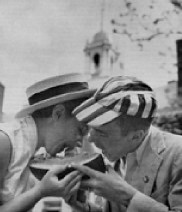1922 An explosion of liquid oxygen in Jefferson Labs takes the lives of an engineering graduate student and a carpenter working in the building.
1927 The John W. Weeks Memorial Bridge is dedicated on May 14. Henry Hornblower, representing the firm of Hornblower & Weeks, formally presented the bridge to Harvard, and the University then turned it over to the Commonwealth of Massachusetts.
The Fogg Museum officially opens on June 20, heralded by the singing of the Harvard Glee Club .
1932 Russell T. Sharpe '28, secretary for Student Employment, comments on the effect of the Great Depression on students, noting that the number of job hires has gone down while the number of students applying for term-time jobs has gone up significantly.
1937 The film company Pathé Topics releases a new short film about John Harvard's Birthplace.
A riot breaks out in Harvard Square as more than 2,000 Harvard undergraduates generate a disturbance for no apparent reason. Traffic is held up for an hour, and then, with shouts of "On to Radcliffe," the "rioters" march up Garden Street, only to be "greeted by buckets of water from many young ladies' windows." The Cambridge police eventually arrive and disperse the crowd with tear gas.
1942 The 1,600 members of the Harvard ROTC units march in a parade review from the Yard to Soldiers Field, lining up for inspection in front of Dillon Field House. After a 19-gun salute in honor of Massachusetts governor Leverett Saltonstall '14, the Board of Overseers and high-ranking military officers inspect the troops.
President Conant and his wife plan to move out of the President's House and into Dana House for the duration of the war so that the Naval detachment of Cambridge can use the larger building as their headquarters.
1947 On a visit to Harvard to collect an honorary degree, T.S. Eliot '10 observes, "Nobody ever seems to stop working. It was certainly never like that in my day." Rather than being part of the Lost Generation, Eliot calls the undergraduates "a Worried Generation."
 |
| Marlowe A. Sigal |
1957 Debate erupts on campus after Newsweek suggests that religion is back in fashion at Harvard. The magazine article cites a Student Council committee recommendation (itself based partly on a random questionnaire handed out in the Yard) that formal study of religion be offered in a more systematic way than in certain General Education courses.
1962 Construction begins on Peabody Terrace, which will house about 500 married graduate students and their families.
The Brattle Theatre agrees to schedule a Humphrey Bogart Festival during reading period after all, following student protest over Bogie's omission from the theater's spring line-up.
1967 The chief of psychiatry at University Health Services, Graham B. Blaine '40, publishes an article that discusses the prevalence of student loneliness on campus and suggests that Harvard and Radcliffe consider "removing some of the competitiveness from the emotional climate of Cambridge."
1972 In a statement published in the Crimson, 35 students admit participating in the recent occupation of Massachusetts Hall by the Pan-African Liberation Committee and the Harvard-Radcliffe Association of African and Afro-American Students. The protestors, who want Harvard to sell its Gulf Oil stock to protest Gulf's operations in Angola, denounce the faculty's disciplinary body as a kangaroo court.
Psychologist Matina Souretis Horner is named the sixth president of Radcliffe. At 32, she is the youngest person ever to hold that office.
1977 Under a new agreement, Harvard and Radcliffe will maintain a coordinate relationship: Radcliffe will retain its institutional independence but delegate responsibility for undergraduate affairs and instruction to Harvard.
1982 Piqued by rumors that the Kennedy School of Government might (in an era of Republican ascendancy) change its name to the Harvard School of Government, the Cambridge city council votes to change the name of the street where the school is located from Boylston Street to Kennedy Street.





